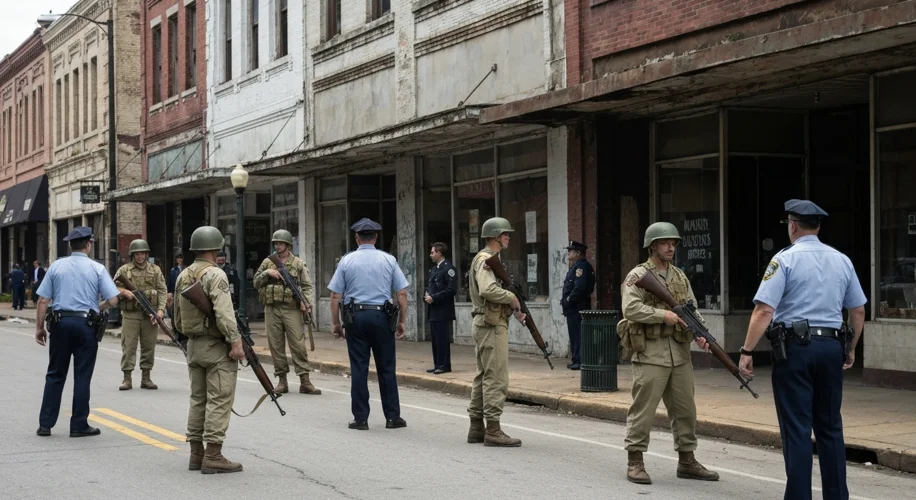The air in Memphis, Tennessee, in the spring of 1968, was thick with a tension that could be felt in the marrow of one’s bones. It was a tension born of injustice, fueled by simmering anger, and amplified by the persistent drumbeat of a national struggle for civil rights. In the midst of this charged atmosphere, a sight that spoke volumes about the precarious state of American society began to appear with unnerving regularity: National Guard troops, their olive-drab uniforms a stark contrast to the city’s brick and mortar, patrolling alongside local police.

The deployment of federalized troops, even in a domestic capacity, was never a casual affair. It signaled a breakdown in civil order, a point where the state felt compelled to use its military arm to quell unrest. In Memphis, this particular moment was inextricably linked to the sanitation workers’ strike, a courageous and prolonged fight for fair wages and humane working conditions. The city’s Black sanitation workers, fed up with dangerous jobs, meager pay, and systemic discrimination, had taken to the streets under the powerful slogan, “I Am A Man.”
This was not merely a labor dispute; it was a profound assertion of human dignity. However, the city’s response, marked by heavy-handed tactics and a refusal to negotiate in good faith, ignited a firestorm of protest. Dr. Martin Luther King Jr. arrived in Memphis to support the striking workers, lending his immense moral authority to their cause. His presence, while a beacon of hope for the protestors, also cast a long shadow of apprehension over the city’s leadership and, indeed, over the nation.
The days leading up to April 4, 1968, were fraught with escalating conflict. Peaceful marches were met with tear gas and violence, and the growing presence of the National Guard became a chilling visual testament to the deepening crisis. These soldiers, many of them young men from ordinary American backgrounds, found themselves thrust into the heart of a social and political maelstrom. Their orders were to maintain order, to prevent further violence, and to ensure the city’s infrastructure remained operational. But the optics were undeniable: the United States military, trained for foreign battlefields, was now a visible presence on the streets of an American city, a stark reminder of the deep divisions fracturing the nation.
The presence of armed soldiers on patrol was a double-edged sword. For some residents, it offered a semblance of security amidst the chaos. For others, particularly the African American community, it was a painful echo of historical oppression, a visual representation of a government willing to use force against its own citizens demanding basic rights. The soldiers, with their bayoneted rifles and stoic expressions, became symbols of the state’s power, and the line between protecting property and suppressing dissent was often blurred in the public’s perception.
The tragic assassination of Dr. King on April 4, 1968, shattered the fragile peace and unleashed a wave of grief and rage across Memphis and cities nationwide. Riots erupted, and the National Guard’s role shifted from patrol to active crowd control, underscoring the gravity of the situation. The images of soldiers confronting protestors, of smoke rising from burning buildings, and of a nation reeling from the loss of its most prominent civil rights leader, were broadcast across the globe, painting a portrait of a country in turmoil.
The aftermath of Dr. King’s assassination and the ensuing unrest left an indelible mark on Memphis and on America. While the sanitation workers’ strike was eventually settled, the deployment of the National Guard served as a potent symbol of the federal government’s involvement in domestic civil rights struggles. It highlighted the complex and often fraught relationship between the military and civilian populations during times of profound social change. The patrols, the checkpoints, and the armed soldiers were not just a temporary measure; they were a visible manifestation of a nation grappling with its conscience, a stark reminder of the battles fought not on foreign soil, but within its own borders, for the very soul of its democracy.
The historical resonance of National Guard troops patrolling alongside police in Memphis in 1968 continues to echo. It serves as a critical case study in the challenges of managing civil unrest, the ethical considerations of military intervention in domestic affairs, and the enduring struggle for racial equality. These images, etched into the collective memory, remind us that the fight for justice is often a long and arduous one, and that the presence of armed forces on our streets is a sign of deep societal challenges that demand more than just the imposition of order; they demand understanding, empathy, and a commitment to fundamental human rights.

